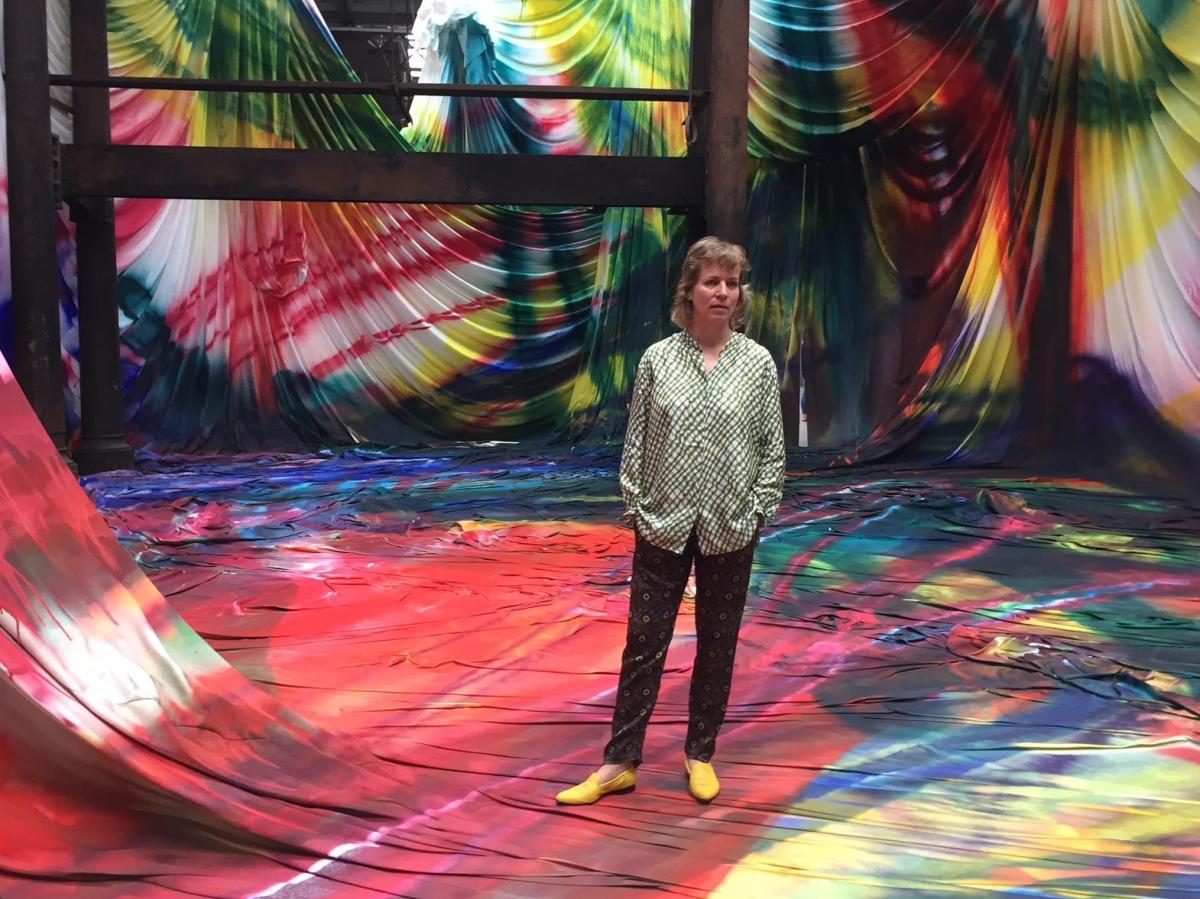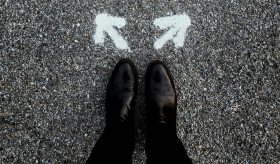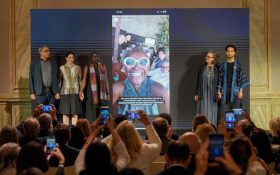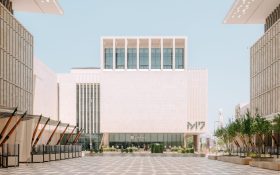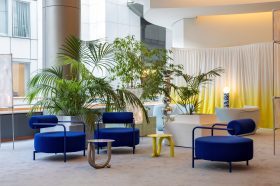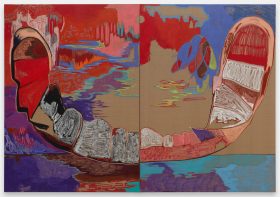Katharina Grosse standing within her Carriageworks installation; Photo: ArtsHub.
Last week, German mega-artist Katharina Grosse unveiled her Sydney Festival installation at Carriageworks, a colourful work comprised of 8,250 meters of fabric – suspended, knotted and draped – which she then took to with a spray gun.
Overnight it became a trending sensation globally on social media. We saw a similar response last year when Grosse painted an abandoned US Army aquatics facility in Fort Tilden Park, Queens – one of the areas hard hit by Hurricane Sandy. Images of the candy-coloured structure circulated wildly on social media channels, adding an uncanny dimension to the experience of viewing Grosse’s work.
Speaking at Carriageworks, Grosse was very aware of this multiplicity – from the painted me, to the environmental and temporal me, to the virtual me, as she put it. She offers a refreshing take on painting in the 21st century, and her influences spring from a mixed bag of triggers, from photographs of paranormal activity and paintings of Renaissance churches, to Edvard Munch’s penchant for painting outdoors and contemporary dance.
Put simply, for Grosse, painting is an experience in immersive subjectivity, where the medium is explored in regards to its locations, its conditions and possibilities.
While perhaps more literally executed in her Fort Tilden Park piece, Rockaway! (2016), temporarily located on a windswept beach, that philosophy is equally the foundation of her work at Carriagworks, titled The Horse Trotted Another Couple of Metres, Then it Stopped.
During her stay in Sydney, Grosse revealed in an artist talk the driving philosophy that lies behind her painting, which we have consolidated here with other interviews about her practice.
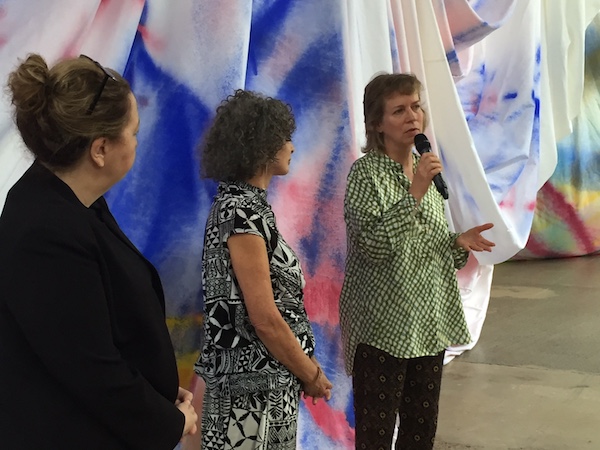
L-R: Carriageworks Director Lisa Havilah, project partner gallerist Anna Schwartz and Katharina Grosse speaking; Photo Artshub.
Yeah, I’m Pablo
How does it start? How does such a free, temporal and visceral installation take form for Grosse, and in this case, how did that Horse first start to trot in Sydney?
‘I am always coming to places with the anticipation of what I will do next; what is the possibility? This [Carriageworks] is a place of such possibility because it is not so clear – is it a theatre, is it painting?
‘I had a chat for maybe two hours [with the Carriageworks team] and there were these little scribbles on a napkin, like Picasso. Yeah, I am Pablo,’ Grosse laughed.
She told ArtsHub: ‘I have never ever made a work like this, which is inserted into an existing space, that is in relation to another architectural idea.’
While Grosse does paint in her Berlin studio, it has been her extended paintings in temporal spaces that have garnered her the spotlight on a global stage.
On invading space
Grosse has always been transfixed by spatial engagement, and the need to extend that space beyond conventional boundaries and definitions.
She told the Brooklyn Rail: ‘I think it’s always been there. As a kid I painted images like volcanoes and wanted more space for them, so I added more paper on all sides, creating larger sheets for more volcanoes.’
She added: ‘I do not invade space. I take it for granted.
‘Whether it is a painting or not, it doesn’t matter. It’s a phenomenon, or it’s a space being opened up to a new dimension beyond what was previously determined by its architecture,’ she told Rail publisher Phong Bui.
Interview with Katharina Grosse about her new Sydney work, The Horse Trotted Another Couple of Metres, Then it Stopped; Produced by Carriageworks
There is no message
Speaking about her Carriageworks installation, The Horse Trotted Another Couple of Metres, Then it Stopped, Grosse said the title doesn’t mean anything. ‘But it conveys an atmosphere; the moment we stop our ritualised, rhythmic movement it opens up your vision to something you haven’t seen before.’
She continued in an earlier interview with Bomb Magazine: ‘I do not have a vision. I am the vision. There are no limits to painting; that´s why I am involved in it. I don’t experience “limits” as limits. There is no resistance when I am painting. The inside and the outside coexist. What appears in the image field is not subordinate to existing reality; it constitutes that reality. I don’t interpret reality; I understand reality as a performative activity that generates itself newly and differently, again and again.’
She added: ‘Painting is an ideal medium to put across this phenomenon of equality and concurrency. It is able to provide all visual particles on the picture plane simultaneously.’
Grosse’s practice is all about working in the moment. Speaking to a group gathered at Carriageworks, she spoke intimately about her making: ‘I experience thinking as very fast, as if it is running through my brain like a storm. For me the information I get from visual residue is higher than other residues.’
She continued: ‘I do my thinking in my movement and I do not use language or imagery coming from photography or quoting other things. I am really interested in the fact that I think or feel or register a difference between me and my environment, or relationship with environment, before they start to flop into various boxes (or categories).’
For Grosse, the folds of the fabric and her palette of raw, kaleidoscopic colour is the main carrier for “anything” – it is an open proposition. ‘Colour has the ability to draw you in, in a really, really powerful way – like the sound of a voice … and before you know it you are already looking at something,’ she said.
Grosse prefers to use colour directly out of the can for its rawness and truth. She first started applying paint via a spray gun in 1998 for an installation at Kunsthalle Bern.

Outside view of The Horse Trotted Another Couple of Metres, Then it Stopped at Carriageworks, Sydney 2018; Photo ArtsHub
On the concept of folding space
What makes Grosse’s new work in Sydney unique is the way the paint sits on the folds of the fabric, somewhat velvety and ethereal. And yet, as a visitor trips on a fold walking across this installation, a flash of white – or nude canvas – is revealed. It is a sensation that Grosse both enjoys and embraces.
‘When you have a fold you cover something and I think that is super interesting,’ she told ArtsHub.
‘I started to work with it [the fold], as I wondered if what I don’t see is as influential as what I see, but also as a painter you understand you are painting a lot of layers on top of another in the beginning – [largely] because you don’t like what you do – but later because you think it is a strategy … So painting is quintessentially doing nothing else than folding information onto a surface in a very elaborate way,’ she explained.
Grosse takes this vast surface of the fabric and shrinks into it by folding it, in part hiding space and in part illuminating form. She first introduced the use of voluminous fabric into her painting practice in 2014.
Time lapse video on the making of The Horse Trotted Another Couple of Metres, Then it Stopped; courtesy the artist and Carriagworks
Four bodies moving as one
Grosse described the process of painting The Horse Trotted Another Couple of Metres, Then it Stopped: ‘When I work with a little team it is as thought my body is being made bigger.
‘The team had to change from the makers of what you see from the outside, to the role of being totally committed to my painting body. I have people on the machine that feeds the paint continuously so I am not interrupted at all, so I can paint for 5 minutes or 2 hours.’
She continued: ‘It was this constant movement of four people in the end working around me to make that work. I had another two people in the space just moving the hose and the ladder – we were not talking at all; we developed this kind of sign language … I could paint the whole thing over in a day, and I did that for 10 days.’
It is not surprising that Grosse has been deeply influenced by contemporary dance, in particular the work of choreographer and dancer Pina Bausch, whose repertoire she regularly followed through her career. Bausch’s unique style was a blend of movement, sound, and prominent stage sets, working in an improvised, collaborative way.
Grosse said of her own process: ‘It is a very interesting process that changes not only the work but changes yourself.’
Push me, pull me
The team, the space, the environment – these are the dynamics that push you as an artist, is a thought at the heart of Grosse’s philosophy.
She explained to her Sydney audience: ‘When you do something you haven’t done before, when you don’t know how your painting will survive – you are pushed into a situation where you are not sure if you will accept your art – a situation where you are not comfortable with your work.’
Grosse continued: ‘That is an unpleasant situation, but when that comes about you know you are about to do something you haven’t done before. I like to be in a zone that is not comfortable and gives me the next big energy boost [in my work].
It was the first time that she has made a space for painting that is totally independent from the exhibition space but nontheless relates to it.
She added of the Schwartz-Carriageworks collaboration that commissioned the Sydney work: ‘Without institutions ready to fund and collaborate with these very difficult works we would not be able to make these jumps in our practice – that is something so important.’
She added that what comes out of these projects is really difficult to measure – to quantify – and stressed that just because of that their value should not be overlooked.
Bring on the circus
Making a work of this scale and complexity is not just a case of filling up the spray gun and going for it.
‘I worked with a sewing plan and a rigging plan and three different scale models in my Berlin studio. How this team managed to understand the dynamics of weight – the dynamics of weight being pulled in a direction – and how to synchronise all their thoughts when different knots come in and the dynamic shift.’
She likened the process of creating a work like this as akin to cooking. ‘Everything is described and measured. A cooking recipe is the same but it doesn’t always come out the same way as the photograph. It is a little same here.
‘This is the first time I could use this amount of fabric and work with a very inventive, interesting team, where people came from circus practices and the film world and they would create with my team.’
Grosse said: ‘I felt a little like an intruder into my own work.’
But this installation, The Horse Trotted Another Couple of Metres, Then it Stopped is very much a Katharina Grosse signature work, carrying all the hallmarks of why she is regarded as one of the most important artists working in our times.
The Horse Trotted Another Couple of Metres, Then it Stopped is the third in the series of Schwartz Carriageworks international commissions. It has been programmed for Sydney Festival. You can catch it at Carriageworks until 8 April 2018.
